Stejcraft power boats have enjoyed a long connection with the Australian boating fraternity, having originated in Victoria in 1972 and being manufactured there for many years.
Today Stejcraft have moved to warmer climes and are now manufactured on Queensland’s Gold Coast, from a factory in the Coomera Marine Precinct. Modern production and manufacturing techniques prevail, with all underfloor stringers of fibreglass. Foam fill between the outer hull and inner liner is also standard.
This review involves the Stejcraft Islander 580, powered by a 115 Yamaha Salt Water series 2-stroke outboard. The very attractive craft was presented by Broadwater Boating of Labrador, and I put it through its paces in the Gold Coast Seaway and Broadwater on an unusually calm day. Perhaps too calm. But there was an opportunity for a run outside the Seaway where the craft revelled in the prevailing low swell. We also jumped some very serious wash thrown up by numerous aquatic behemoths plying the Broadwater, and it was easy to see just how well the Stejcraft Islander 580 rode.
I boarded the Islander as its bow nosed into the beach in the Southport Broadwater, which gave me an excellent opportunity to assess the features up front. A split bowrail facilitated boarding and moving up and into the cab without a hiccup. A wide and quite deep drained anchor well was (fortunately) lidded, which made my entry into the cabin even easier.
The Stejcraft cabin was thoughtfully set up. While within the quite large cabin hatch area up front I enjoyed strong support both from the padded sides of the hatch as well as padding at the front of the bunks: obviously tending anchor would be quite comfortable. The hatch cover itself could be securely fastened from within the cabin to keep water out.
In the cuddy cab, proper large side windows let in ample light, as did the entry area. Full length side pockets were equipped with generously padded outer sections which in turn provided excellent back support while seated on one of the cabin’s full length bunks. These bunks had deep storage compartments under them, and an infill was provided to turn them into a large bed if required. The provision of a Porta Potti was an option; note that the cabin foot well was drained under the clip-out carpet. In all, I saw the cabin as a very comfy place to spend a bit of rest time or for storing important items.
Aft of the Stejcraft’s 5-piece glass windscreen, a wide dash area extended full width. A pair of cup holders were prominent, as was a compass over towards the skipper, where a raised panel was set up with gauges and instruments to monitor the Yamaha 115 2-stroke. Uppermost were paired engine gauges, lower were a Lowrance Mark-5X sounder and a GME VHF marine radio next to the steering wheel. There was plenty of room to install a larger sounder if necessary. To port, and lower, was an array of switches with the craft’s ignition key to starboard of the wheel. Engine controls were side mounted in the usual fashion.
Forward seating consisted of well padded and form-fitting swivelling bucket-style seats on pedestals. Both seats featured slide adjustment with a front bolster section that could be flipped up when standing to drive. The front passenger had a recessed grabrail to port while both skipper and mate had bed-end type footrests to use as well. Side pockets along the cockpit also extended up to this forward area so that skipper and mate could stow a bit of kit in there if necessary.
In all, a very useful seating arrangement, and there was also a bimini for additional weather protection. The strong but foldable bimini frame was equipped with a 5-station rocket-launcher style rod holder to complement the paired rod holders in each cockpit side deck.
With its clip-out carpet, 2m long side pockets (which to starboard were equipped with rod holders) featuring mesh along their sides plus toeholds under them, the Stejcraft Islander 580’s 760mm deep cockpit was well set up for fishing. A side grabrail was incorporated under the gunwales, and the cockpit carpet was of a very heavy-duty variety. It sat atop a non-skid floor, providing the option of leaving it at home. Tuna fishing comes to mind here as those fish can be mighty messy in a boat.
The rear seating was interesting. Two well-padded modular seats, providing enough room for four people, sat atop removable and drain-equipped fish boxes. The boxes were 750mm long by 350mm wide, and their padding was removable so you could easily take them off the boat for a clean up at fishing’s end.
Importantly, the lounge positioning was flexible. The L shape would be easy to set up if you wanted to use the boarding area to starboard.
An underfloor storage compartment was also available, but if the Stejcraft was mine I’d be putting food in there, keeping the removable boxes for the smelly fish.
A livebait tank was set to port within the full-height transom. Although paired boarding platforms were located aft each side of the Yamaha 115, the craft’s ladder was set to starboard where you could remove a section of backrest to provide a low step-over section to enter the cockpit after a swim.
Aft of the transom, the Yamaha Saltwater 115hp V4 2-stroke sat deep within a full-height engine well. The boat is rated from 75-140hp, so the Yamaha 115 was middle of the range. As such it did a very easy job of planing the craft (with 2 aboard) at a speed of 18.4km/h at 2700rpm. 3000 rpm saw 24.7km/h recorded, 4000rpm saw 44.2km/h, 5000rpm a speed of 62.3km/h and 6000 rpm a feisty 71.2km/h.
Driving the rig to assess speeds was a treat. The non-feedback steering proved to be very light, with the craft responding very well to driver input. The 1.7L Yamaha 115 proved quietly smooth, not at all smokey, was mighty responsive to throttle input and had more toe than a roman sandal.
The Stejcraft’s ride was exceptionally good. Some massive craft were plying the Broadwater at the time and I took delight in powering over wash at speed just to see how the Stejcraft handled things. Not only was impact quite light, the ride remained quiet, thanks to foam fill and a hull design that incorporated several useful features to enhance both performance and ride.
Stability was a big factor. With a hull weight of 890kg the Stejcraft was mighty solid. Not surprisingly, the craft with its under-hull strakes, broad outer reversed chines and central Delta plank all mated to a 19 degree V hull sat very flat at rest. It offered degrees of stability that would make it both ideal for family use as well as serious fishing pursuits.
One interesting about the Islander’s hull design was the ‘hook’ or break in the outer chine that allowed air to push under the hull at speed.
As a fishing rig the Stejcraft ticked a lot of boxes. The user-friendly layout, on-board fishing features, excellent ride and handling plus stability at rest all pointed to it being a craft that could handle many fishing scenarios, from bay or estuary to offshore work.
I saw the Stejcraft 580 Islander as the sort of rig that could double as a serious fishing or family boat, depending on your needs. The 115 Yamaha 2-stroke was an ideal motor for extended travel to fishing areas, family touring or fun time.
Comfortable bunks, a deep cockpit, easy performance plus seating for up to 7 persons gave the new Stejcraft an air of versatility. The finish was very good, from the deeply lustrous gel coat to the well stitched upholstery.
On an Oceanic trailer with spare wheel, safety gear and all registrations when supplied by Broadwater Boating, the Islander would be $43,990. You can find out more at www.broadwaterboating.com.au or you can call the friendly Broadwater team on 07 5529 1777.
Facts
SPECIFICATIONS
| Length | 5.80m |
|---|---|
| Length on trailer | 7.4m |
| Height on trailer | 2.85m |
| Beam | 2.35m |
| Weight of hull | 890kg |
| Hull deadrise | 19 degrees |
| Fuel | 130L |
| Engine ratings | 75-140hp |
| Engine | Yamaha 115 hp 2-stroke |
| Max persons | 7 |
| Towing | Family 6 sedan or 4x4 |
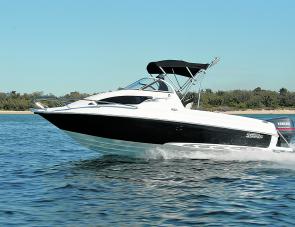
This shot of the Stejcraft running along at speed highlights the sleek hull design, plus the easy efficiency of the hull.
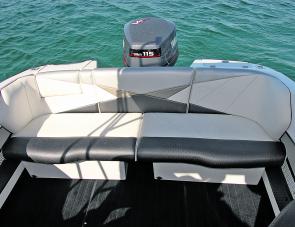
The 4-person modular lounge can easily converted to an L shape, and the storage boxes are easy to remove for cleaning.
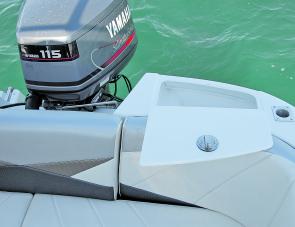
The craft’s transom-mounted livewell was equipped with a decent cover and latch to prevent water spilling.

A wide and generously padded cabin hatch provided very easy access to the Islander’s anchor.
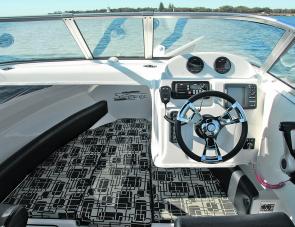
The dash layout immediately catches the eye, as does the high standard of finish in this boat.
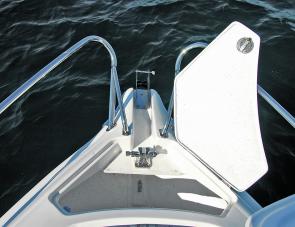
Once that lid is locked down, ground tackle will be well and truly secured.
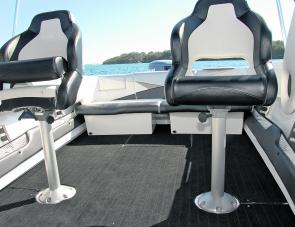
This view aft shows the drained boxes on which rear seats are mounted, plus the quality of the craft’s clip-out carpet. Note the full-length side pockets for easily accessible storage space.

The Stejcraft 580 Islander is a very handsome lady, with on-water manners to match.
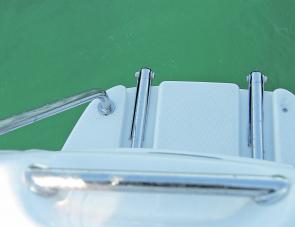
The strong telescoping ladder and broad boarding platform make it easy to climb aboard after a swim.




